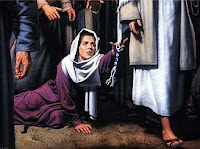Tefillin are worn each morning (except on the Sabbath and holidays) and during the afternoon on Tisha B'Av (a summer holiday commemorating the destruction of the ancient Temples). With a special formula of blessing, they are usually put on at the very beginning of the morning prayer service and kept on through its conclusion. First comes a meditation to help us get spiritually focused on the task. Some use words that spring from their hearts. Others utter prayers that are included in most prayer books. This is one of my favorites, penned by Rabbi Rami Shapiro:
I welcome this morning in peace; opening my heart to wonder and feeling the presence of God around and within me. I reach out and connect with all those who lift their souls in prayer, adding my voice to theirs in a choir of peace and healing.Then the arm is placed through the loop of the tefillin. We pause and say a blessing before wrapping the arm:
We temporarily wrap the remaining length of strap around the hand and pause so that we can place the head tefillah (singular) where it belongs, on the forehead. We pause once again for a second blessing, much like the first, followed by a statement of affirmation:Barukh ata Adonai Eloheynu Melekh ha-olam asher kidshanu bemitzvotav vetzivanu lehaniach tefillin.Praised are You, Adonai our God, Sovereign of the universe, who has made us holy with mitzvot and instructed us to wrap tefillin.
Barukh ata Adonai Eloheynu Melekh ha-olam asher kidshanu bemitzvotav vetzivanu al mitzvat tefillin.Praised are You, Adonai, our God, Sovereign of the universe, who has made us holy with mitzvot and instructed us concerning the mitzvah of tefillin.
Then as we unwrap the loosely wrapped hand and wrap it again in a particular way around the fingers and hand, we recite words from the prophet Hosea:Barukh Shem kavod malchuto l'olam vaed.Praised is God's name whose sovereignty endures forever.
It is one complete sequence of rituals, done without interruption.Ve'ayrastikh lee l'olam ve'ayrastikh lee betzedek u'mishpat u'vchesed u'vrachamin ve'ayrastikh lee be'emunah veyda'at at Adonai.I will betroth you to Me forever. I will betroth you to Me with righteousness, with justice, with kindness and with compassion. I will betroth you to Me with faithfulness, and you shall know God.
Tefillin are wrapped around your weaker arm. Therefore, right-handed people wrap them around the left arm, and left-handed around the right arm. While the manner in which they are wrapped differs slightly in some communities (for example, some wind clockwise while others wind counterclockwise), the straps of the tefillin symbolically spell out the letters that form a name of God (Shaddai/Almighty; note that shaddaim is the Hebrew word for "breasts," emphasizing the nurturing aspect of God).
Each tefillah contains four excerpts from the Scriptures, but the order and placement of these biblical texts differs for each one. In the tefillah for the arm, all four section appear together on one piece of specially prepared parchment, written by hand with special ink. On the head tefillah, the excerpts are written on four separate pieces of parchment and separated into sections.
CHRISTIAN PRAYER-TOOL PARALLELS
There is one mention in the New Testament of tefillin. In the Gospel of Matthew, Jesus makes a comment about the phylacteries that the Pharisees in the Temple are wearing: "The scribes and the Pharisees sit on Moses's seat; therefore, do whatever they teach you and follow it; but do not do as they do, for they do not practice what they teach... They do all their deeds to be seen by others; for they make their phylacteries nroad and their fringes long" (Matthew 23:2-3,5). The comment seems to reflect contempt for those who wear tefillin as an outward sign of piety but who are far from pious in their actions. Interestingly, some scholars do not read this as a rejection of the ritual practice of tefillin. On the contrary, they see this as Jesus literally telling his followers that their tefillin should not be as broad as the Pharisees'. If Jesus himself donned tefillin (a distinct possibility), then the two traditions might have been much closer in practice had the early church sought to emphasize its ties with Judaism rather than playing up its differences.
Christian tradition does not have a close parallel for the donning of tefillin, although the physicality of the tefillin may remind some of the rosary beads that Catholics use for prayer. Traced back to the ninth century, the rosary is used by Roman Catholics and Anglicans to focus their prayers or meditations.
At a deeper level, what the rosary and the tefillin have in common is the desire for a tactile sensation of prayer. Both of these rituals allow you to literally feel prayer in your hands and on your body. This physicality may be a natural impulse for people who pray regularly. Both of these rituals allow the body to pray, as it were, with the mind and the soul.

























